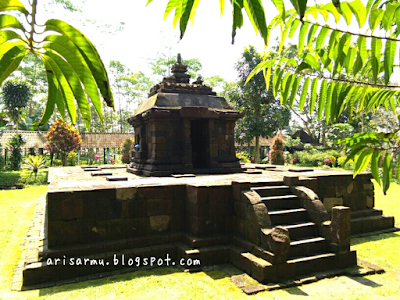Arisarmu - Unlike other Hindu temples in Central Java, Klero Temple is less famous and even almost forgotten by people. Yet it is actually quite interesting to be visited if you are fond of archaeological sites, especially which associated with temples.
Klero Temple was estimated built during 9th to 10th centuries. There is only one single temple without any perwara temples (smaller temples) surrounding it.
The temple is located in Ngentak Hamlet, Klero Village, district of Tengaran, Semarang Regency, Central Java, Indonesia.
The temple is located in Ngentak Hamlet, Klero Village, district of Tengaran, Semarang Regency, Central Java, Indonesia.
If you are from salatiga direction and intend to go there. It is merely 21 minutes drive (9.8 km) from Salatiga. Simply follow Salatiga - Solo Rd. When you already pass through Kembang Sari Market, Tengaran. You nearly arrive at the location. If on the left side you see a gateway (Ngentak-Klero), like in the photo below, enter it or turn left. The temple is approximately 500 m from here.
Next to the gateway is a simple house selling bananas and pumpkins.
If you are from Boyolali direction, in Tengaran you will cross a bridge. About 300 m from the bridge, turn right and enter the gateway like in the previous photo.
 |
| from Boyolali direction |
When I just entered into a small street toward Klero temple, I saw many temulawak (curcuma zanthorrhiza) were being dried up under the sunshine on the street side.
Temulawak has long been known in traditional Javanese herbs for having health benefit, such as improve metabolism and healthy liver function.
Even I saw some clothes were being dried up on fence trees. The environment was truly typical of village life.
Then after passing through some houses, I'd already in the midst of vilagers' gardens. Many of them are banana trees and sengon trees (paraserianthes falcataria). Both trees are very useful and have multi-function as well. Bananas with their varieties can be eaten as a fresh fruit or to make snacks and banana desserts. While sengon trees have been known for making pulp, paper and many more.
I really enjoyed the natural view which was fresh and cool and I almost forgot that I had to turn right. The temple was visible from distance.
When I finally arrived at the area of the temple. First, I saw no one there, only a motorcycle was being parked but I still didn't see the owner, until later I met them, a young man and a young woman, and even a semi permanent warung was empty. I thought the seller was working in her garden and at the weekend she would start selling snacks and drinks at Klero temple. Then I started exploring the temple.
The temple complex is surrounded by fences to separate it with a graveyard and a garden planted coconut trees. The outside, there is a small building, it looks like a counter ticket, but it was closed at that time. Near the entrance gate there is a board with a brief description about the temple. Unfortunately, there isn't much information about Klero Temple. Although I'd been googling for few days before going there.
Cultural Heritage of Klero Temple Site is under the supervision of Balai Pelestarian Cagar Budaya Jawa Tengah (Central Java Institute for Preservation of Cultural Heritage) which lies on Jalan Manisrenggo km 1 Prambanan, Klaten, Jawa Tengah.
Klero Temple Site or the locals commonly call it as Tengaran Temple has quite complete condition. The foot of the temple is rather high and provided stairs to walk up onto it.
There is no relief on the sides of its stairs, just unfinished makaras (mythical creatures) at the foot of the temple.
Klero Temple Site or the locals commonly call it as Tengaran Temple has quite complete condition. The foot of the temple is rather high and provided stairs to walk up onto it.
There is no relief on the sides of its stairs, just unfinished makaras (mythical creatures) at the foot of the temple.
On the foot of the temple, in the middle, there is a small building which its interior has yoni and lingga.
In Hinduism terminology, yoni is also symbol of goddess Parvati who is the wife of god Shiva. And yoni is also a pedestal of lingga which symbolize god Shiva.
The merging between lingga and yoni is meeting between a man and a woman that symbolize fertility. So it will emerge a new life.
Accordingly, the worship of lingga-yoni was blessings for people in the old times. Thus, lingga-yoni was usually put within a farming area or worship place for farmers thereat.
In summary lingga-yoni is the aspect of the embodiment of god Shiva.
Lingga-yoni
Under yoni, there are a small turtle statue and a small dragon statue. Both animals symbolize the underworld. Dragons or snakes also have many meanings, such as symbol of strength, supernatural power, protector and welfare of the earth.
Read more : Belajar Bahasa Inggris Seputar GUA
The temple is square with a rectangular entrance door and niches on its wall.
The roof of its temple has three layers. The first is limasan (a four-sided sloping trapezoidal roof). The second is a smaller square than the first surrounded with antefix decoration on its edges. The third or on the top, there is a form of ratna (something very valuable).
In the complex of Klero Temple, precisely after the entrance gate, there is lumpang-alu (mortar-pestle), but sadly, the pestle is now broken into two.
The traditional food processors are symbol of prosperity as well.
In conclusion, although Klero Temple is unfamous, in fact, by visiting this temple, I've gained knowledge about past life in Tengaran. (arisarmu.blogspot.com)
 |
| Lumpang-Alu |







